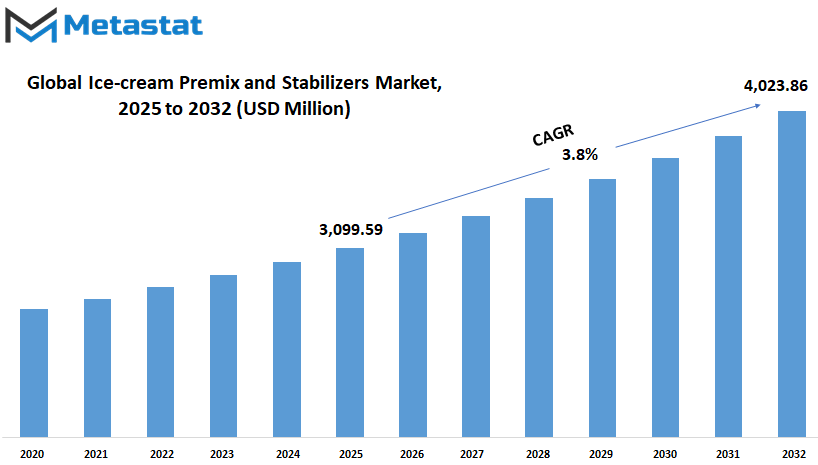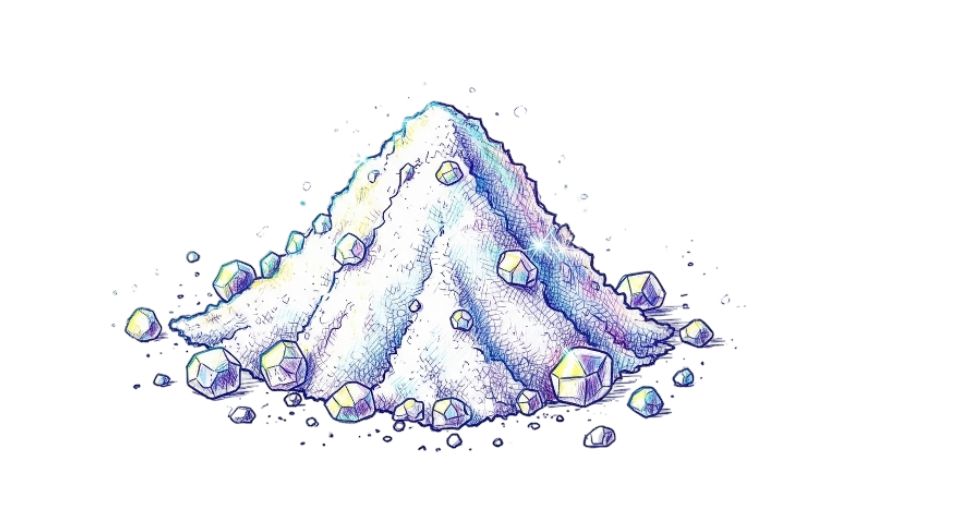MARKET OVERVIEW
The Global Ice-cream Premix and Stabilizers Market is a credible space within the food and beverage industry where innovations are served on a platter toward frozen desert formulation and production process development. And indeed, as consistency, shelf-life, and sensory improvements are sought, so this market becomes integral towards achieving even further product standardization for varying climatic and storage conditions. Though behind-the-scenes-as-an-elements, ice-cream premixes and stabilizers play most significantly the all-important role of providing texture, flavor retention, and structural integrity in final products thereby becoming a must feature in both artisan and industrial ice-cream production.
Importantly, the Global Ice-cream Premix and Stabilizers market will ultimately offer customized solutions to producers who are looking for functional ingredients that support uniform production on a scale. Premixes will comprise a balanced combination of all-important elements in their service: milk solids, sugars, emulsifiers, and flavor bases. All this will lead to condensing operations with reduced differences among different batches. Stabilizers will deliver heat shock and melting resistance as well as mouthfeel and smoothness improvement to the final product. Ultimately, these factors will combine to simplify the otherwise complex task of producing ice-cream for consumers and governments alike, that has moved into higher options for lactose and sugar avoiding product lines, as well as dairy-alternatives, high-protein, and low-sugar products.
During the years ahead, this Global Ice-cream Premix and Stabilizers market will evolve even further in terms of diversifying its product spectrum, to cope with changing consumer behavior and new dietary habits. Manufacturers around the world will bring in regionally tuned recipes focused on local taste profiles, consumption patterns driven by the climate, and logistical roadblocks in the area. This would require custom stabilization systems and premix combinations that can be used under varying environments and transportation conditions. Differing innovations in raw material sourcing and processes will thus lead to an entirely different paradigm in designing premixes and stabilizers, that would make it possible for cleaner-label products at the ongoing performance level.
Producers will definitely be working exclusively on issues of product consistency, especially since expansion geographically will probably also mean increasing numbers of plant locations for the producer. Such activity will be facilitated by the Global Ice-cream Premix and Stabilizers market, with centralized standardization of ingredients for quality control and logistics simplification. This particularly applies to quick service restaurants and packaged ice cream brands that tend to depend a lot on frozen supply chains. Besides, premixes will ease the burden of training and skill levels needed during the production process in a flexible manner towards deployment of the workforce.
Another thing that will determine the Global Ice-cream Premix and Stabilizers market is sustainability and traceability. The demand for transparency all along with the sources of ingredients would continue to exercise pressure over the suppliers to innovate in developing natural stabilizer systems derived from seaweed, plant gums, or seed extracts. The legality would bring about a greater addition of permissible materials while providing impetus for the reformulation of such materials based on the legislation specific to the market. Private labels as well as smaller artisanal brands will create such opportunities as necessitated by flexibility in premixes to allow special customization with little R&D.
These are called the benchmarks of structure and sensory quality for frozen desserts that the future Global Ice-cream Premix and Stabilizers market will keep defining, pulling the industry closer toward operational efficiency, regional adaptation, and cleaner formulations. It will stretch far out of the production line and stretch into the consumer dimensions of texture, taste, and satisfaction by product.
Global Ice-cream Premix and Stabilizers market is estimated to reach $4,023.86 Million by 2032; growing at a CAGR of 3.8% from 2025 to 2032.

GROWTH FACTORS
The Global Ice-Cream Premix and Stabilizers market is set to be in a lasting growth spurt, driven by many important factors for the industry in the future. One of the most significant factors affecting such growth is increasing consumer preference for premium and artisanal ice creams. It requires the need for better premix ingredients and stabilizers that ensure texture and taste, for the more consumers who are flocking for unique and high-quality desserts. Consumers also are willing to pay more for ice creams made from superior and creatively combined ingredients-the market offers a great opportunity for growth with this shifting consumer behavior towards more indulgent, artisanal offerings.
The demand for ice cream products is also increasing due to the expansion and growth of the food service industry as well as the quick service restaurants (QSR). The more multi-productive products with a variety of desserts are added to the menus of restaurants, cafes, and chains of fast food; the demand for premixes and stabilizers will rise. These businesses would want to have uniformity in quality and make it more cost-efficient. Other areas where market growth will be increased include casual dining, with an even greater expansion in QSRs worldwide.
On the downside, there are several challenges likely to hinder the growth of the market. One primary issue affecting the ice cream manufacturers is erratic prices of raw materials, which directly affect the production costs. As prices of crucial ingredients such as dairy and sugar fluctuate, manufacturers may find it difficult to maintain the prices set for the consumers while at the same time ensuring product quality. The increase in awareness concerning the artificial additives in foods is, thus, likely to slow down the market, as the public will be more health-consciousness and therefore demand even cleaner labels. Such transitions in demand could even demand that stabilizers and premixes be rethought.
The development of natural and plant-based stabilizers comes on the good side for the market. More people are looking for stabilizers that are plant-based and match the health-conscious trend, which is becoming more common as time passes. People are becoming more interested in health issues as they seek to reap from nature as much as possible. Providing the future of the Global Ice-cream Premix and Stabilizers market, these factors describe that the industry is to become dynamic and responsive to the changing trends of the climate whereby such clean-label natural and plant-based alternatives will continue to become more important to consumers.
MARKET SEGMENTATION
By Type
The market is defined by a rise in the consumption of food that is indulgent without being especially unhealthy, alongside the rising curiosity about new flavors and textures. Premium ingredients and growing acceptance of plant-based and dairy-free ice creams will shape the future of this market.
In this respect, a useful angle would be stabilizers and premixes-the two important segments that play key roles in delivering such ice cream products to consumers. As a result, stabilizers are likely to see increased demand since their primary function is to improve the texture, consistency, and shelf life of ice creams.
Consumers are now after products that will give a smoother and creamier texture, so they will depend much on balance. These ingredients will become more specific with improvements in freeze-thaw stability, melt resistance, and mouthfeel-all contributors to that premium ice cream experience much in demand.
Innovations will likely be aimed at stabilizer formulas to take care of the increasingly health-conscious consumer base. Premixes will continue to serve as a quick and efficient solution for ice cream manufacturers in the coming years.
There is also increased scope for demand, alongside a growing trend for unique customized flavors. With pre-blended ingredients simplifying the process of production, premixes reduce production time and cost, making them increasingly attractive even to both small and scale producers.
These changes are going to proceed in the coming years for both stabilizers and premixes-forever changing their form in scope with consumer preference, regulatory differences, and changes or advances in technology.
As the market grows, such segments will be inextricably intertwined, paving the way for more innovative products on all fronts in terms of quality, variety, and health. They are going to drive future demand towards sustainability, clean-liableness, and novel development in frozen dessert formulations, which makes them indispensable for the future of ice cream.
By Stabilizer Type
The Global Ice-cream Premix and Stabilizers market is expected to see substantial growth in the coming years. This is largely due to changing consumer trends toward diversity and innovation in regard to frozen dessert products. The role of stabilizers is vital in the production of ice cream by enhancing textural properties, consistency, and shelf life. As the developments in the market take place, different stabilizer types will be used in variable proportions to achieve desired product results. The prospects of this market look pretty bright since every stabilizer type brings in its advantages into the production practice.
Agar, as a plant-based stabilizer, is getting traction owing to the increasing awareness and demand for vegan and vegetarian choices. The more popular plant-based ice creams will further increase the demand for agar. Well known for its gelling properties, it helps establish the overall texture of ice cream while providing it with a smooth, creamy feel, free of animal-derived ingredients. This running theme toward healthier and sustainable food options is anticipated to extenuate demand for agar in the near future.
Gelatin, which has been used traditionally for many frozen desserts, continues to find acceptance as a stabilizer in ice cream. Although its use is limited in vegan and vegetarian products, it continues to remain the most favorable stabilizing agent for consumer acceptance. Its presence aids in the realize of excellent ice cream texture and mouthfeel properties. In the growing market, gelatin will most likely find support from brands manufacturing traditional ice cream recipes, characterized with a creamy texture.
Xanthan gum is another stabilizer that will become increasingly popular in the future. Xanthan gum shows promising thickening and stabilizing properties across a wide range of products. In ice cream, it enhances the overall textural properties while simultaneously preventing ice crystallization. In varied applications across different varieties of ice cream, xanthan gum must play an instrumental role in accommodating the rising demand for quality products exhibiting a creamy, indulgent experience.
Carrageenan is a red algae derivative and used to stabilize ice cream more than any other. Usually, it just tries to improve texture and keep ingredients from separating, thereby assuring consistent product delivery. Carrageenan will continue to hold strong on the market as natural becomes of prime importance in formulations, especially where clean label and natural sources are of utmost concern.
Guar gum has been another plant-based stabilizer, and it remains important in the production of low-fat and sugar-free ice cream. It would soften the products and impart a thickening effect. It will find a new lease of life in this niche as the health-conscious consumer continues to crave lighter desserts.
Concomitant with the forthcoming advancement of the Global Ice-cream Premix and Stabilizers market, the mixture of these stabilizers will lead to better and newer formulation solutions for ever-changing consumer needs.
By Application
The demand for global premixes and stabilizers in ice cream is anticipated to grow significantly with more developments in consumer trend towards increased variety and convenience with frozen desserts. These products continue to be applicable because they are in high demand for easy-to-prepare, good-quality frozen treats such as ice cream, frozen yogurt, sorbet, gelato, and ice pops. Apart from the taste, these products are becoming popular because of health and dietary awareness. Premix and stabilizers optimize the final product as per consumer expectations regarding texture, flavor, and shelf life.
Still, one of the leading applications of premixes and stabilizers is ice cream, where consumers worldwide continue in search of new flavors and textures. The emerging trend of premium and artisanal ice cream products will generally cause an increase in the incorporation of trendy ingredients and custom formulations which will further fuel the development of specialized premix and stabilizer solutions. The rising number of ice cream varieties enjoyed by people contributes to increased demand for improved stabilizing agents with less variation in quality and consistency of the end product due to changes in ingredient formulations.
This market segment has an impressive list of fast-growing products in the next several years. With growing preferences for frozen yogurt over traditional ice cream, consumers will push manufacturers to invest even more on specialized premixes and stabilizers to perfect the flavor and texture of the final product to meet health-conscious standards. The new generation of frozen yogurt is non-dairy and plant-based yogurt, which will likely open new opportunities in the premix and stabilizer market because of having different stabilizing requirements.
The interest is also rising for sorbet and gelato. More often made with fruit and having fewer ingredients compared to upscale ice cream, sorbet benefits from premixes and stabilizers by maintaining its promise texture and flavor while under frozen conditions. Denser and richer than ice cream, gelato is now being liked keenly in different parts of the world. With increasing demand for these desserts, premixes and stabilizers will stand to gain ground in the market for products leveraging on the increasing need for high-quality formulations that can be counted on by special characteristics.
Ice pops are another growing category in the market, especially those having innovative flavors and value-added health benefits. With upward trends in interest regarding frozen snacks that are both happy and healthy at the same time, the demand for premixes and stabilizers that give texture and stability in these products is anticipated to continue rising. Thus, all applications will require more custom stabilizing solutions to ensure their optimum quality and consistency because consumers generally want healthier alternatives.
By Distribution Channel
The Global Ice-cream Premix and Stabilizers market is expected to grow in the coming years, driven by appreciation for the product in consumer preferences or improving efficiency in manufacturing processes. Throughout history, ice cream has been one of the most popular desserts. Thus, as manufacturers start noticing premixes and stabilizers for bettering the characteristics of products, the demand for premixes and stabilizers is likely to experience further growth. Thus, it can be seen that the future for market distribution channels for ice cream premixes and stabilizers depends heavily on innovations and advancements in food technology, along with a steadily increasing demand for fast, easy-to-take-away solutions.
Traditionally, the major channels for the distribution of ice cream products have been supermarkets and hypermarkets; this trend is expected to continue. These big retailers will stock up flavors of ice cream premixed for consistency and quality. Supermarkets and hypermarkets will continue to be core actors in placing these products in the hands of many consumers who demand convenience. They are also the space where, in conjunction with advertising, they showcase innovations made by brands in their ice cream products that increase the demand for premixes and stabilizers.
Convenience stores, predictably, will maintain sustained demand as ice-cream premixes and stabilizers' distribution channel. As people are getting more inclined toward ready-to-eat snacking options, convenience stores stand to gain from growing demand for quick-fix treats. Impulse buyers flock to these stores for odd little purchases; stocking ice cream products made with high-quality premixes and stabilizers will allow them to woo buyers looking for a superior experience. As urbanization trends grow, taking up lives toward fast-paced consumerism, convenience stores will definitely stand a strong competitor when it comes to ice cream product Distribution.
Online Retail is another great opportunity for the bright future of this market. E-commerce has been on an upward trajectory, and the online ordering of ice-cream premixes and stabilizers adds further convenience. Online platforms allow consumers access to a far wider variety of products than they may be able to find in physical stores, which in turn can contribute to the increasing utilization of specialized ice-cream products. The convenience of shopping from home and comparing prices and products will most likely serve as motivators for customers to purchase the ice-cream premixes and stabilizers via digital channels.
Specialty stores will serve to stimulate the growth of this market in view of the ever-growing demand for unique and premium ice experiences. These stores, in essence, cater for specialized niche markets, marketing products which are mostly unavailable in larger retail stores.
|
Forecast Period |
2025-2032 |
|
Market Size in 2025 |
$3,099.59 million |
|
Market Size by 2032 |
$4,023.86 Million |
|
Growth Rate from 2025 to 2032 |
3.8% |
|
Base Year |
2024 |
|
Regions Covered |
North America, Europe, Asia-Pacific, South America, Middle East & Africa |
REGIONAL ANALYSIS
The Global Ice-cream Premix and Stabilizers market an opportunity for major change. Has there been transformation due to consumer preferences, technical development, and convenience in the food world? A view into the geographical distribution of the market illustrates how each region's growth and evolution will characterize the market differently. With a global following for ice cream treats, the demand for premix and stabilizers will still allow its manufacturer to get on with the road of perfection for producing good economic products everywhere.
The North American region is slowly establishing an imprint on the use of premix for ice cream, as consumers prefer more premium and indulgent products. The ice-cream markets of North America comprise: Canada, The United States: and Mexico; these large ice-cream markets require manufacturers to employ premixes in order to maintain consistent texture and taste. In light of the evolution of consumer tastes toward healthier, plant-based, and organic alternatives, suppliers must adapt by developing increasingly customized premixes and stabilizers. They will, therefore, still play a big part in ensuring technological advances in the flavors and textures.
The ice-cream market would likely follow a similar pathway in Europe. In fact, in this region, the whole spectrum of diversified flavors and artisanal products have seen enormous demand for high-end, high-quality stabilizers and premixes. The UK, Germany, and France serve as hosts for renowned ice cream brands, whereas the new Southern European markets are rapidly adopting these ingredients in order to increase production efficiency. As European consumers pursue ever more natural options with clean labels, the premix market will continue to migrate toward sustainable and health-related options.
The fastest growth within the Global Ice-cream Premix and Stabilizers market is likely to happen in the Asia-Pacific region. As disposable incomes continue to increase in countries like China, India, and Japan, ice cream has become a treat that is affordable for the masses. High demand for both traditional and modern innovations means that manufacturers in this part of the world will be depending more upon premixes and stabilizers to fulfil the requirements of mass production without compromising on quality. Markets in South Korea are also becoming strong, with increasing appreciation for novelty and premium advents in ice cream. As these markets grow, there will be demand for enhanced production-to-consume processes, and this will result in growth in the premix and stabilizer section.
Brazil and Argentina will be the leading South American nations in ice cream consumption, while pre-mix consumption is steadily increasing. Regional mass ice cream producers and their international counterparts will lean on premixes for the better quality of production and cost-effectiveness as they strive to fulfill the increase in demand presented by the dynamic and young population. Meanwhile, in the Middle East and Africa, the likes of Egypt and South Africa have increasing disposable incomes.

COMPETITIVE PLAYERS
The Global Ice Cream Premix and Stabilizers industry promises to grow significantly in the future, mainly due to the increasing demand for ready-to-use ice cream products and continuous changes in consumer preferences. To get the desired texture, consistency, and shelf life of the end product, these premixes and stabilizers are important in the production processes of ice cream. As this market thrives, key players will continue to play a key role in shaping the market, among them are Cargill, Incorporated, CP Kelco U.S., Inc., Palsgaard A/S, and Jungbunzlauer Suisse AG.
But looking ahead, companies must pursue innovation and sustainability if they are to meet the increasing demand for healthy alternatives and clean-label products. Consumers have become more health-conscious, and the trend of using more "natural" ingredients with no artificial additives has certainly gained traction. Companies such as Palsgaard A/S and Sunita Hydrocolloids Inc. might, therefore, be working on designing stabilizers and premixes based on natural sources while retaining the creaminess and mouthfeel of ice cream.
In addition to that, the increasing number of dairy-free and vegan ice creams would also boost this market for Premix and Stabilizers in Ice Cream. Thus, special formulations would be needed for such brands in order to get the same texture or mouthfeel of dairy-based ice creams. Leading in delivery of stabilizers and premixes tailored for plant-based ice creams is expected to be Neelkanth Polymers and Vikas WSP Ltd.
The demand for ice cream products is set to increase with the emergence of new markets in developing regions such as parts of Asia-Pacific, Africa, and South America. The affordability and availability of ice cream premixes and stabilizers will facilitate the entry of manufacturers in those regions with good ice cream products for local consumers. The same urbanization would create higher demand for processed and convenience foods which would further boost the use of ice cream premixes and stabilizers.
The Global Ice Cream Premix and Stabilizers market will likely continue to grow steadily as both established and new entrants into the market focus on product innovations, sustainability, and addressing the changing consumer needs. Hindustan Gum, Ashapura Proteins Ltd., and M/s. Abdullabhai Abdul Kader would continue to expand their products, keeping the market dynamic and in tune with consumer needs. The importance of these key players in shaping the future of the ice cream industry will only increase as the market attains its new dimension.
Ice-cream Premix and Stabilizers Market Key Segments:
By Type
- Stabilizer
- Premix
By Stabilizer Type
- Agar
- Gelatin
- Xanthan Gum
- Carrageenan
- Guar Gum
- Others
By Application
- Ice Cream
- Frozen Yogurt
- Sorbet
- Gelato
- Ice Pops
- Others
By Distribution Channel
- Supermarkets and Hypermarkets
- Convenience Stores
- Online Retail
- Specialty Stores
- Others
Key Global Ice-cream Premix and Stabilizers Industry Players
- Cargill, Incorporated
- CP Kelco U.S., Inc.
- Palsgaard A/S
- Jungbunzlauer Suisse AG
- Neelkanth Polymers
- Vikas WSP Ltd.
- Sunita Hydrocolloids Inc.
- Hindustan Gum
- Ashapura Proteins Ltd.
- M/s. Abdullabhai Abdul Kader
- Avlast Hydrocolloids
WHAT REPORT PROVIDES
- Full in-depth analysis of the parent Industry
- Important changes in market and its dynamics
- Segmentation details of the market
- Former, on-going, and projected market analysis in terms of volume and value
- Assessment of niche industry developments
- Market share analysis
- Key strategies of major players
- Emerging segments and regional growth potential








 US: +1 3023308252
US: +1 3023308252






